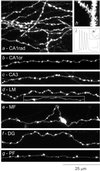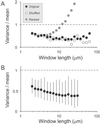General and variable features of varicosity spacing along unmyelinated axons in the hippocampus and cerebellum
- PMID: 11972022
- PMCID: PMC122950
- DOI: 10.1073/pnas.052151299
General and variable features of varicosity spacing along unmyelinated axons in the hippocampus and cerebellum
Abstract
Along unmyelinated central axons, synapses occur at focal swellings called axonal varicosities (boutons). The mechanisms regulating how frequently synapses and varicosities occur along axons remain poorly understood. Here, to investigate varicosity distribution patterns and the extent to which they may be conserved across different axons, we analyzed varicosity numbers and positions along fluorescently labeled axon branches in hippocampal area CA1 (CA3-to-CA1 "Schaffer collateral" axons) and five other synaptic regions of rat hippocampus and cerebellum. Varicosity spacing varied by region; e.g., 3.7 +/- 0.6 microm (mean +/- SD) for CA3-to-CA1 axons and 5.2 +/- 1.0 microm for cerebellar parallel fibers. Surprisingly, when 56 axons from these different regions were pooled into a single heterogeneous group, a general relationship emerged: the spacing variability (SD) was a constant fraction of the mean spacing, suggesting that varicosities along different axons are distributed in a fundamentally similar, scaled manner. Varicosity spacing was neither regular nor random but followed a pattern consistent with random synaptic distributions and the occurrence of multiple-synapse boutons. A quantitative model reproduced the salient features of the data and distinguished between two proposed mechanisms relating axonal morphogenesis and synaptogenesis.
Figures






Similar articles
-
Axonal varicosity distributions along parallel fibers: a new angle on a cerebellar circuit.Cerebellum. 2003;2(2):110-3. doi: 10.1080/14734220310011407. Cerebellum. 2003. PMID: 12880178 Review.
-
A quantitative analysis of the laminar distribution of synaptic boutons in field CA3 of the rat hippocampus.Neurosci Res. 2004 Jun;49(2):241-52. doi: 10.1016/j.neures.2004.03.002. Neurosci Res. 2004. PMID: 15140566
-
Conduction latency along CA3 hippocampal axons from rat.Hippocampus. 2003;13(8):953-61. doi: 10.1002/hipo.10141. Hippocampus. 2003. PMID: 14750657
-
Properties of horizontal axo-axonic cells in stratum oriens of the hippocampal CA1 area of rats in vitro.Hippocampus. 2004;14(2):232-43. doi: 10.1002/hipo.10170. Hippocampus. 2004. PMID: 15098728
-
Activity-dependent axonal and synaptic plasticity in the cerebellum.Psychoneuroendocrinology. 2007 Aug;32 Suppl 1:S31-5. doi: 10.1016/j.psyneuen.2007.04.016. Epub 2007 Jul 20. Psychoneuroendocrinology. 2007. PMID: 17640822 Review.
Cited by
-
Kv7/KCNQ/M-channels in rat glutamatergic hippocampal axons and their role in regulation of excitability and transmitter release.J Physiol. 2006 Oct 1;576(Pt 1):235-56. doi: 10.1113/jphysiol.2006.111336. Epub 2006 Jul 13. J Physiol. 2006. PMID: 16840518 Free PMC article.
-
Use dependence of presynaptic tenacity.J Neurosci. 2011 Nov 16;31(46):16770-80. doi: 10.1523/JNEUROSCI.3384-11.2011. J Neurosci. 2011. PMID: 22090503 Free PMC article.
-
Dopamine Transporter Localization in Medial Forebrain Bundle Axons Indicates Its Long-Range Transport Primarily by Membrane Diffusion with a Limited Contribution of Vesicular Traffic on Retromer-Positive Compartments.J Neurosci. 2021 Jan 13;41(2):234-250. doi: 10.1523/JNEUROSCI.0744-20.2020. Epub 2020 Nov 24. J Neurosci. 2021. PMID: 33234607 Free PMC article.
-
The effects of axonal beading and undulation on axonal diameter estimation from diffusion MRI: Insights from simulations in human axons segmented from three-dimensional electron microscopy.NMR Biomed. 2024 Apr;37(4):e5087. doi: 10.1002/nbm.5087. Epub 2024 Jan 2. NMR Biomed. 2024. PMID: 38168082 Free PMC article.
-
Beyond faithful conduction: short-term dynamics, neuromodulation, and long-term regulation of spike propagation in the axon.Prog Neurobiol. 2011 Sep 1;94(4):307-46. doi: 10.1016/j.pneurobio.2011.06.001. Epub 2011 Jun 17. Prog Neurobiol. 2011. PMID: 21708220 Free PMC article. Review.
References
Publication types
MeSH terms
LinkOut - more resources
Full Text Sources
Miscellaneous

